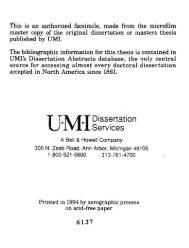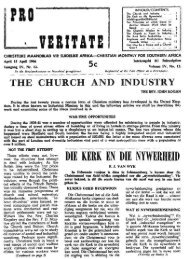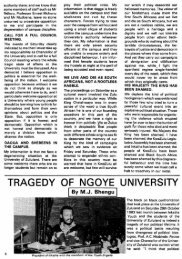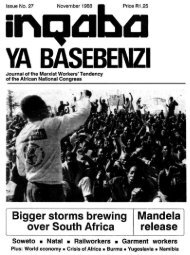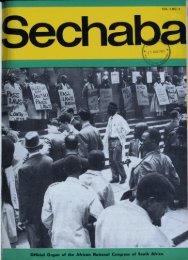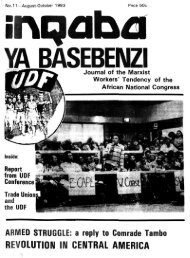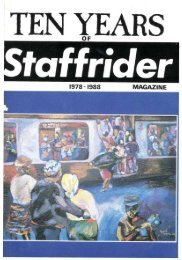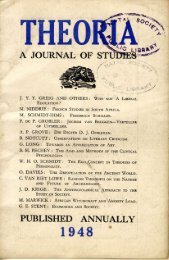Inqaba ya basebenzi Number 2 April 1981 - DISA
Inqaba ya basebenzi Number 2 April 1981 - DISA
Inqaba ya basebenzi Number 2 April 1981 - DISA
You also want an ePaper? Increase the reach of your titles
YUMPU automatically turns print PDFs into web optimized ePapers that Google loves.
14<br />
.USA REACTION<br />
As US president Reagan recovers from<br />
the bullet of a would-be assassin, the<br />
question remains— where is America<br />
going under this right-wing administration?<br />
The election of ex-cowboy film-actor, Ronald Reagan,<br />
as President of the United States reflects the crisis of the<br />
ruling class as well as widespread disillusionment of a<br />
big section, perhaps even a majority, of the American<br />
masses.<br />
Only 52% of ihe voters bothered<br />
to go to the polls—a drop from 54%<br />
in 1976 and 62% in 1964. This was<br />
despite the fact that 10 million 18-21<br />
year olds were voting for Ihe first<br />
time in the 1980 election.<br />
Reagan's victory shows the combination<br />
of apathy and uncertainty<br />
among the voters which has destroyed<br />
the ability of either of the two<br />
pro-capitalist parties—Republicans<br />
or Democrats—to build long-term<br />
majority coalitions. This instability<br />
is rooted in the crisis of capitalism.<br />
In 1976 the American voters<br />
placed Carter in office because he<br />
promised full employment, a balanced<br />
budget, and low prices. Four<br />
years later none of the promises had<br />
been fulfilled. Instead the economic<br />
situation had worsened—unemployment<br />
at 8 million, inflation running<br />
at 12.5% and the government<br />
spending far exceeding what it<br />
received by 27.5 billion dollars.<br />
The new President has also come<br />
into office with promises—of lax<br />
cuts to "stimulate investment",<br />
reductions in government interference,<br />
lower inflation and a "healthy<br />
vigorous growing economy" to<br />
reduce unemployment.<br />
But even the capitalist experts<br />
hold out little hope for him being<br />
able to measure up to his lofty<br />
promises. The Economist (Novem-<br />
THE SADDLE<br />
BUT RIDING FOR A FALL<br />
by Teboho Ptiiri<br />
he will be judged by 1984 to have<br />
failed.,." It goes on to speak of<br />
"another one-term failure".<br />
Thus even these spokesmen of<br />
capitalism have realised the inherent<br />
instability that bedevils even the<br />
strongest capitalist power.<br />
To understand the crisis of<br />
American capitalism, it is necessary<br />
to look closely at the rise and fall of<br />
the dollar and the changed position<br />
of the United States in the world<br />
economy after World War II.<br />
Bretton Woods<br />
The USA emerged enormously<br />
strengthened after World War II,<br />
the only real victor among the<br />
capitalist powers. It controlled<br />
nearly 50% of world capitalist<br />
production, 70% of capitalist world<br />
trade, and had 80% of the capitalist<br />
world's gold in its vaults.<br />
Thus in 1944 the United States<br />
was able to impose the Bretton<br />
Woods monetary agreement on the<br />
dollar, its value fixed at 35 dollars to<br />
the oz of gold, became the main<br />
currency of the world trade. It was<br />
on this basis that the American<br />
government was able to print<br />
massive quantities of currency that<br />
were not backed by gold or the real<br />
value of production.<br />
In the years after Bretton Woods<br />
the United States poured out dollars<br />
overseas at a far greater rate than it<br />
was getting back. It did this through<br />
Marshall Aid, buying and investing<br />
in industries in Europe, and military<br />
expenditure in acting as policeman<br />
of world imperialism.<br />
Dollar crisis<br />
As long as the US remained the<br />
major capitalist power, with the<br />
dollar the unchallenged world currency,<br />
she could continue with the<br />
policy of printing more dollars. But<br />
with the emergence of West Germany<br />
and Japan as serious trade<br />
competitors of the American capitalists,<br />
her position declined.<br />
The policy of printing dollars<br />
eventually led to the crisis of the<br />
dollar. The fiction could no longer<br />
be maintained that an ounce of gold<br />
was worth only 35 dollars. And the<br />
US government could not provide<br />
gold for all the dollars it had printed.<br />
To avoid complete financial<br />
collapse the US was forced to abolish<br />
the right of holders of dollars to<br />
exchange them for gold. The dollar<br />
was devalued. Capitalists around the<br />
world holding dollars rushed to cash<br />
them in for other currencies and the<br />
ber 1980) writes "The odds are that rest of the capitalist world. The dollars piled up as reserves in the



